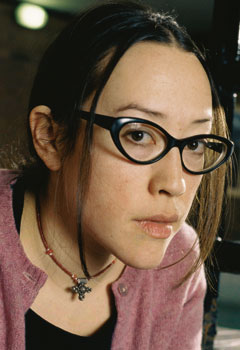CONTENDERS
Training, fighting, struggling against all odds – boxing, come to think of it, is a lot like making an independent film. It’s not surprising, then, that the sport should prove particularly inspiring to first-time filmmakers. Here, Peter Bowen sits down with Girlfight director Karyn Kusama and Shadow Boxers’s Katya Bankowsky.
Girlfight director Karyn Kusama. Photo by Richard Kern
Boxing – with its physical clash between two evenly matched opponents in a spare, theatrical setting –has long been the perfect cinematic subject, spawning its own subgenre of sports film. And ever since Sylvester Stallone launched his film career by producing, writing and starring in Rocky, the boxing movie has become the ultimate debut feature. But the idea of the boxing film as personal crucible achieved new heights this year at the Sundance Film Festival, where debuting feature director Karyn Kusama won the Grand Jury Prize for Girlfight (to be released by Screen Gems), a tightly scripted and keenly observed drama about a young Latina who finds both personal empowerment and romantic complication through boxing. While the film, with its classically structured narrative, shows Kusama to be a natural storyteller, its take on the sport owes much to Kusama’s own experience boxing at Brooklyn’s Gleason’s Gym.
Filmmaker invited Kusama to talk with Katya Bankowsky, whose own debut feature, Shadow Boxers (self-distributed though Swerve Production Company), recently finished a theatrical run. Bankowsky’s film, a documentary about female boxing star Lucia Rijker, was also inspired by the filmmaker’s personal experience training to fight. Here then, two young directors discuss women’s roles in film, melodrama and the love of the fight. Peter Bowen moderated.
Katya Bankowsky: Do you think boxing is a good thing for girls to do?
Karyn Kusama: Oh, absolutely!
Bankowsky: Me too. But I think it’s an interesting question, because throughout the making of my film, over six years, I went in and out of moments of thinking that this sport is ridiculous, that nobody should be doing this. You meet so many people in the boxing world who are completely damaged by the sport.
Kusama: Who can’t even talk anymore …
Bankowsky: Did you have mixed feelings about boxing when you were making your film, too? Your film also has a positive message about using boxing to empower yourself.
Kusama: Oh God, yeah. There’s nothing worse than seeing the really gruesome bouts. You can talk in these elevated terms about the purity and beauty of the sport, but then you see people’s brains practically falling out of their head.
Filmmaker: Katya, did your film arise from an interest in boxing, or did you start off knowing the film would be about Lucia Rijker?
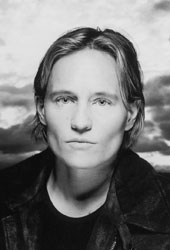 |
| Katya Bankowsky, director of Shadow Boxers. Photo by Josef Astor. |
Kusama: When anyone – mostly guys –would talk shit about Girlfight as an idea, calling the film an impossibility or unreality, I would say, "There’s a fighter you need to see who will silence you, and her name is Lucia Rijker!"
Bankowsky: Well, Lucia provided me with the character I was looking for. With Lucia, I could make a film about boxing and not specifically about gender. I didn’t want to make a movie that was didactic, a film that said, "Look at what women today are doing!" Lucia Rijker, because she breaks down the stereotype of what a female boxer might be, allowed me to make a movie that breaks down stereotypes of how women are depicted on film.
Filmmaker: Karyn, how did you go about constructing your protagonist and finding Michelle Rodriguez to play her?
Kusama: Well, the character was someone I saw every day in New York City – someone who was really pissed off, had a lot of presence and a kind of urban braininess but had nowhere to put all of that energy. I wanted to see on screen a girl who could live without apology, who couldn’t be dismissed and then who, through a very traditional, classical narrative, finds herself. And Michelle had that mix of rawness, an incredible presence and an inability to fit in herself. So many times when we see outsiders who are given a heroic status, they are men, and I was interested in seeing a female who occupied that same territory.
Bankowsky: Were you initially looking for an actor who could play this role?
Kusama: I was hoping for a trained actor because the shooting schedule was so intense. But it’s funny, when women become actors through the traditional means, it’s part of the job to feminize oneself. I would say, "Show up in plain clothes that essentially cover your body," and so many women, who were clearly very talented, would still show up in push-up bras and miniskirts, even though it was the dead of winter! Most of the actresses I talked to and auditioned had lost that raw quality. Then I realized that I needed someone who was unpolished, and it became apparent it was going to be a non-professional. Michelle had done some extras work in film, and we found her through an open call.
Bankowsky: It’s interesting, because in making a fiction film you created a character in your mind and then went out and found a real person, not an actor, who embodied that character. I also "found" a character I had in my mind. But I still had to "write" the story I wanted to tell. I could have made a million different permutations of Lucia’s story. And it became a battle with outside investors, because they really wanted me to tell a safer story.
Kusama: What was the safer story?
Bankowsky: The safer story is what we’ve always seen – when a strong woman steps outside of the normal boundaries, you bring her back in in a very overt way. You show her putting on her makeup and heels and going on a date with her boyfriend. [These investors] wanted that. They said, "The movie will not work if you don’t show us how normal she really is." Whenever you see a strong woman in a film [the filmmakers] always have to do this thing where they go over the top trying to feminize her to prove that she is "normal."
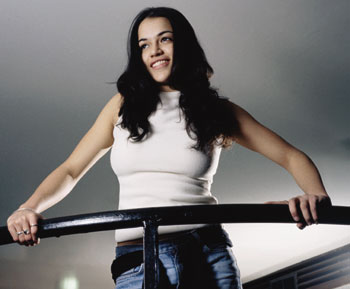 |
| Girlfight star Michelle Rodriguez. Photo by Richard Kern. |
Kusama: Or she loses her mind, or eventually her power becomes purely sexually manipulative.
Bankowsky: I wanted to show a female character without apology, without going back and saying, "But look at her, she’s also very sweet and feminine, and here she is in her evening gown."
Kusama: You do show the teddy bear in her room.
Bankowsky: That was hers!
Kusama: I always intended to make a very fictional movie. I wanted to create a situation outside of the bounds of reality, which is I think what a lot of narrative filmmaking should admit it’s doing. A lot of people have addressed this film as if it’s some sort of social realism or something. I’m shocked by this, because I feel Girlfight is so clearly a highly constructed movie. I’ve always thought of the film as a kind of melodrama.
Filmmaker: But in a good way.
Kusama: I don’t think melodrama is a bad word. I actually love a lot of melodrama – The Hustler, by Robert Rossen; On the Waterfront, by Elia Kazan. These were movies that at the time were considered realistic, but now when we look at them we realize that they are part of a tradition of melodrama. [Characters in these films] finally come to a point where they become naked and say what they feel, which to me is outside the realm of our reality most of the time. Most of the time we don’t really talk about our deepest feelings or fears or all that crap. I love the fact that in these films people actually call out who they are. It’s an ideal world that I think would be a great one to live in.
Filmmaker: Girlfight’s narrative has something of a fairy-tale quality to it.
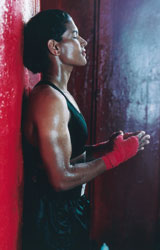 |
| Lucia Rijker in Shadow Boxers. Photo by Michel Comte. |
Bankowsky: I was wondering about your ending, where she wins the fight. To me, it made the whole film metaphoric, because it took it out of the level of reality. Given the two characters who are cast – you can see that unless you let your imagination go wild, she was not going to beat him in a fight. At least, it’s not set up that way. They seem to have been training roughly the same amount of time, [but] he looks a lot bigger and a lot more physical and stronger than her.
Kusama: I think there was a point where I just had to give myself over to the metaphorical thing entirely, because reality just wasn’t going to work. And I knew that there were going to be purists, like myself, who would say, "This isn’t part of the real world!" But then I felt like, well, movies are so often not realistic. I wanted to take the images of men, women, and violence and put them in another context. [In film], we mostly see violence by men against women, and I wanted to realign it, see it in another way. And I knew there was a fantasy element to it.
Filmmaker: Karyn, I heard a story about you fighting in the gym with your sparring partner – a man – telling you that you weren’t hitting him hard enough.
Kusama: That’s how this whole story came about. I was in the gym, becoming really interested in this environment as an environment for a story, and I was wondering where the women were. I was trying to figure out how a woman character could emerge. And then I had to spar with this kid named Adrian, a really beautiful guy who I had always thought had this weird kindness. We sparred, and I was shy about hitting him, and he kept getting me in a headlock and whispering in my ear, "Hit me, hit me!" – over and over again. It was just great! I have to say, to have somebody encouraging that in me was a really wonderful thing. And I thought, this is what’s missing from so many women’s lives: somebody saying, "Hey c’mon, hit me, it’s all right!" I found an intimacy in that moment that no one else outside the ring can experience, because it was literally a whispered thing.
Filmmaker: You both entered boxing from very different worlds than the ones your heroines come from. Does boxing mean something different for you personally than it does for your characters?
Bankowsky: Well, I am a professional filmmaker and an advertising producer. I have a safe white-collar job. There was a certain amount of tension throughout the filming of Shadow Boxers, because at times Lucia would say to me, "You know what I want from boxing? I want to have power like you have power. You sit here with all these guys from your crew, and when you tell them what to do, they do it." She said, "People listen to you. People won’t listen to me unless I’m the champion of the world and am making lots of money. I just want what you have – a voice." So then I would tell her about all the horrible things that happen when you try to make an independent film, and she ended up saying she’d rather be a boxer than a filmmaker! She felt it was less difficult, ironically.
Kusama: I see the logic there.
Bankowsky: When you were hanging out at Gleason’s Gym, did you meet any resistance from people saying, "Why are you making a boxing film?"
Kusama: I was lucky, because I had spent so much time there – I walked into that gym in 1993 – so I had real relationships with people there. I wasn’t just a fly on the wall trying to be a voyeur. But I definitely felt that tension in terms of authenticity, and not just about the world of boxing but about the family and the characters I was trying to depict. I guess I feel like if being a filmmaker means that you always have to be depicting your immediate world, then I don’t want to be a filmmaker, because I’m not really convinced that my immediate world is all that interesting.
Bankowsky: You mean you’re not going to make a movie about making a movie? Those are hot!
Kusama: Yeah, exactly. I mean, it’s always been the case, but right now in movies there’s a real unquestioning interest in rich white people. You never even address the fact that they are rich and white – they just are, and we accept it. And then you make a movie like Shadow Boxers or Girlfight, and suddenly there’s this discussion of race. I didn’t want to address "race." There are other people than just white professionals in the world.
Filmmaker: For both of you as first-time filmmakers, filming the boxing sequences must have been challenging.
Kusama: It was a lot to deal with. I think if I hadn’t trained, I would never have been able to do it, because I wouldn’t have spoken the language. I love so many of those boxing movies – I love Fat City because it’s about losers, I love The Set-Up because it’s kind of in real time. But many of them have a very over-choreographed, unrealistic vision of boxing – a big knockout punch and the guy falls to the ground! That’s just not how it is. And here I was telling a story about amateurs who had not trained very long and who were in the lower-weight divisions. There’s more desperation, more scrappiness, lots of pulling apart by the referees, so I wanted to create a different style.
Filmmaker: Raging Bull seems to have been the movie that changed the look of the boxing film.
Kusama: But to me Raging Bull was more about style, aesthetics and family relationships than it was about boxing. Scorsese might disagree.
Bankowsky: Actually, my challenge to myself was, how do I shoot a fight and make it not realistic. How do I shoot it in a stylized way? I didn’t want to make it look like HBO or Showtime. I never showed more than a few seconds of every round. I had two different cameras shooting in two different ways – I intercut black-and-white slow motion with color full-speed. I wanted to choreograph each fight so it told the story of what’s going on behind the fight, behind the punches. That was my challenge, to take it out of the world of reality and bring it into the world of the story I was trying to tell.
Kusama: When you did that thing with [the punch to Lucia’s ear] and her not being able to hear, that was so great. I was like, what a nightmare! I could feel her pain. The moment when [coach] Freddy Roach is in her face giving her the next bit of information to survive the following round and you know she can’t hear, it’s just incredible. I was just like, this is what every boxing film wishes it could be.
Bankowsky: It was funny, because when that fight was done, I sort of said, "Oh my god, this is supposed to be the end of the film, this is the climax – Lucia won the world title – but it was not a very interesting fight." After the fight I found out that she had lost her hearing; you can’t see that while watching the fight. So then I was able to cut that fight and tell a dramatic story.
Filmmaker: Karyn, you obviously chose not to be subjective in terms of the way you shot the boxing.
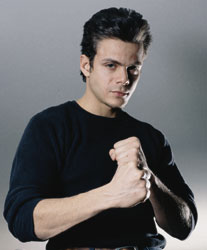 |
| Girlfight co-star Santiago Douglas. Photo by Richard Kern. |
Filmmaker: Women are often positioned as bodies in films. But there’s a completely different representation of the woman’s body in boxing, it seems to me.
Kusama: Absolutely, and when people talked to me about putting money into this movie, they often asked, essentially, "Where’s the sex?" And I would say, "In every frame of the film!" There is nothing hotter than the human body taken into self-realization. On a purely visual level, to see a very powerful woman sweating and her skin sort of glistening, that’s extremely erotic, isn’t it? Once the film got made, people realized there was some kind of visual pleasure here.
Filmmaker: How did each of you finance your movies?
Bankowsky: When I got out of college, I wanted to be a filmmaker, but I realized that it takes a lot of money. So I got a job in advertising working as a commercial producer, which I used as my film school. My first feature film was Shadow Boxers. My professional work not only served as film school but it served as my way of funding my film. I had to do both of them concurrently. At one point I had people who were offering to back the whole film and get me out of debt, but they got scared. They wanted too much creative control and got very nervous about the topic — "Are people really going to be interested in women’s boxing?" So we parted ways, and I finished the film myself.
Kusama: I worked in film for about 10 years after I graduated film school, and eventually I hooked up with John Sayles, who was a good match for me because he had always figured out ways to work independently. I had tried to get money with my first producer for another project for two years, and it was not happening. John said, "What about that boxing story you were working on?" He’s a big sports fan. So I decided to change gears and do Girlfight. I got the script into shape, and then we spent two years looking for the money. It was an incredible experience. People would come to the table with all this enthusiasm and interest but with a lot of different strings – like changing the lead to Caucasian or having the character be some kind of sex symbol. Or there was a real discomfort with the fact that Michelle remains a boxer. One company, who will remain unnamed, actually said, "Can’t she just open a restaurant at the end?" So finally John Sayles, after watching this process of me and my producer, Martha Griffin, trying to get money for over four years, said, "I can’t take it anymore. I’m just going to put up the money, as much money as you need to get started, and then hopefully you’ll find more money to offset my investment." The movie was eventually budgeted at a flat $1 million. And so he put up the initial money, we got started with casting and we got going with everything, and then the Independent Film Channel came in after feeling comforted by his investment and his confidence in the project.
Filmmaker: Do women bring something different to boxing? Is there a certain element of the violence that’s different? Is violence at all gender specific in some ways?
Bankowsky: When women are physically aggressive they have to think about it and justify it, because people ask you why. When a man is physically aggressive, like guys in training camp, that’s the role model they grew up with.
Kusama: I think you’re right. Violence is the province of men, but it doesn’t exist only in men, and this is where we get into all these cultural dilemmas.
Bankowsky: Women have always been taught to be ashamed of their aggression and to hide it as much as possible.
Kusama: Or to bury it.
Bankowsky: Or to bury it and let it eat you up inside. So in the boxing ring, you have to embrace your aggressive instincts or you’re not going to win. For a woman, [boxing] goes against everything she’s been raised to be. So when a woman enters the arena of boxing, she approaches the aggression from a much more cerebral place – she has to have already reconciled it to herself.
Kusama: I think for some women boxing is a cerebral process. And then there are those women for whom it’s actually not; violence is just a part of their life. I feel like all we have to do is walk down a city street to see how much violence has seeped into all of our lives. I sparred quite a bit to get more in the head of the screenplay, and I hated it, I have to say. I didn’t have the will to hurt or be hurt as deeply as would be required for anyone who could pass any kind of muster as a boxer. Other women or men, I think they find it in themselves. For me, I thought, it’s a lie. It’s a lie for me to go into the ring and beat the crap out of someone or get the crap beaten out of me and then say it’s anything but kind of hellish, because it’s just not who I am. There was something else about the sport that appealed to me personally and physically, but I realized at my core that I just was never going to be a fighter – in the ring, anyway.
Bankowsky: But then again, you probably wouldn’t have any trouble ripping somebody’s head off verbally.
Kusama: No, not at all!
Bankowsky: That’s the thing. Women are taught to avoid physical confrontation, but they can get away with much more than men can verbally. I mean, a woman can push everyone around verbally and get her way, and no one’s going to touch her.
VOD CALENDAR


 See the VOD Calendar →
See the VOD Calendar →

